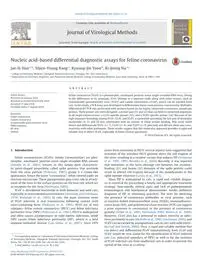
2014 Nucleic acid-based differential diagnostic assays for feline coronavirus PDF
Preview 2014 Nucleic acid-based differential diagnostic assays for feline coronavirus
Journal of Virological Methods 208 (2014) 21–25 Contents lists available at ScienceDirect Journal of Virological Methods journal homepage: www.elsevier.com/locate/jviromet Nucleic acid-based differential diagnostic assays for feline coronavirus Jae-Ik Han a,b, Shien-Young Kang a, Kyoung-Jin Yoon b, Ki-Jeong Na a,∗ a College of Veterinary Medicine, Chungbuk National University, Cheongju 361-763, South Korea b Department of Veterinary Diagnostic and Production Animal Medicine, College of Veterinary Medicine, Iowa State University, Ames, IA 50011, USA Article history: Received 26 January 2014 Received in revised form 8 July 2014 Accepted 11 July 2014 Available online 1 August 2014 Keywords: Feline coronavirus Canine coronavirus Transmissible gastroenteritis virus Differentiation RT-PCR Inosine a b s t r a c t Feline coronavirus (FCoV) is a pleomorphic, enveloped, positive-sense single-stranded RNA virus. Owing to the differences in its genotype, FCoV belongs to a separate clade along with other viruses, such as transmissible gastroenteritis virus (TGEV) and canine coronavirus (CCoV), which can be isolated from cats. In this study, a PCR assay was developed to differentiate these coronaviruses concurrently. Multiplex differential RT-PCR was performed with primers based on the highly conserved coronavirus membrane protein. Three primer sets were designed: a primer pair (S1 and S2) that can bind to conserved sequences in all target coronaviruses, a CCoV-specific primer (S3), and a TGEV-specific primer (S4). Because of the high sequence homology among FCoV, CCoV, and TGEV, a nucleotide preceding the last pair of dissimilar nucleotides in S3 and S4 was substituted with an inosine to allow primer binding. This assay could detect and differentiate FCoV (n = 7), CCoV (n = 4), and TGEV (n = 8) precisely and did not show any cross- reactivity with other pathogens. These results suggest that this molecular approach provides a rapid and reliable way to detect FCoV, especially in feline clinical specimens. © 2014 Elsevier B.V. All rights reserved. 1. Introduction Feline coronaviruses (FCoVs; family Coronaviridae) are pleo- morphic, enveloped, positive-sense single-stranded RNA viruses (Simons et al., 2005). Viruses in this family have characteris- tic petal-shaped projections called spike proteins that protrude from the virus particle (Pedersen, 1983), giving it a crown-like appearance, hence the name “coronavirus”, when viewed under an electron microscope. These glycoproteins play a key role in attach- ment of the virus to the surface proteins on the host cell, which act as receptors for the virus (Hartmann, 2005). FCoV is distributed worldwide in both domestic and wild cats, especially in overcrowded environments (Horzinek and Osterhaus, 1979; Barlough et al., 1983). In cats, the most common route of FCoV infection is oral transmission following contact with virus-containing feces (Pedersen et al., 1995). FCoV are of two subtypes—feline enteric coronavirus (FECV) and feline infectious peritonitis virus (FIPV) (Pedersen et al., 1981). FECV is widespread and often causes asymptomatic or mild enteric infections, while FIPV causes feline infectious peritonitis (FIP), which is a fatal immune-mediated disease (Can-Sahna et al., 2007). Since FIPV ∗ Corresponding author at: Laboratory of Veterinary Laboratory Medicine, College of Veterinary Medicine, Chungbuk National University, Cheongju 361-763, South Korea. Tel.: +82 43 261 3296; fax: +82 43 261 3224. E-mail address:
